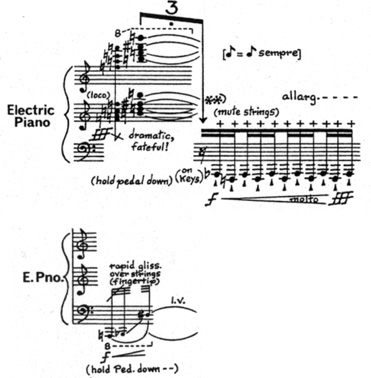Page 7, end
of first line, beginning of second line.
Example of muted pitches and of glissando over bass strings produced by
the fingertip.
For the first page of Voice of the Whale, the pianist is asked to keep
the damper pedal depressed during the extended flute solo in order to maximize
resonance and sympathetic vibrations of overtones. On the second page of
this Vocalise, the piano makes its first entrance with a continuation of
the opening of the Richard Strauss Also sprach Zarathustra theme. Low,
muted bass notes are played after the two big chords. This time, there
are no harmonics produced, but we instead hear the actual pitches stopped
in the manner of a string pizzicato.
The right hand plays the A-flat and F-natural on the keyboard, while pressure
is applied on the two corresponding strings with the left hand. It is most
effective to place one finger on the ends of each string closest to the
tuning pins. This approach allows for maximum resonance and control of
dynamics.
A rapid glissando to be played on the strings immediately follows. These
glissandos are found frequently in this piece. This one is to be played
simultaneously with the flute’s first note. Crumb gives specific
instructions regarding how to play the glissandos. This glissando is to
be played with the finger tip, which produces a more rounded-out “whoosh”
sound suggestive of a large wave. I have found that it is best to use only
one finger and to keep the finger flat. If the finger is curved in any
way, then the strings would be more likely to touch each other while vibrating,
which would create too much clang.

| LUNA NOVA HOME> Extended Techniques for Piano> Glissando Ex. 1 |
||
George Crumb, Voice of the Whale, Vocalise (. . .for the beginning of time) |
||
